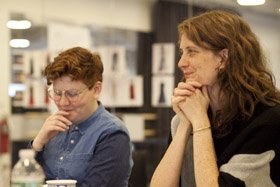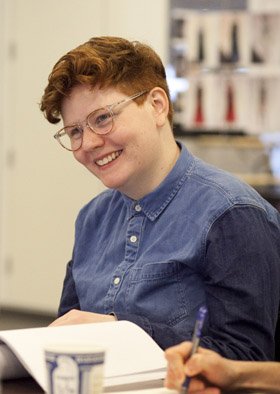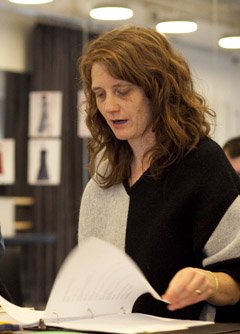LCT3-D
Adding a new dimension to LCT3 with a series of in-depth conversations.
BRYNA TURNER AND LEE SUNDAY EVANS
Author and Director of BULL IN A CHINA SHOP
In conversation with Natasha Sinha, LCT3 Associate Director
Natasha Sinha(Associate Director/LCT3): Welcome to LCT3, Bryna and Lee! We are so excited and proud to produce Bull in a China Shop, especially in this particular moment in American history. Bryna, this is your professional theater debut, and Lee, this is your first time at LCT3—so to start out, can each of you tell me how you got into theater?
Bryna Turner(Playwright): You start!
Lee Sunday Evans (Director): No, you start! (Laughter)
BT: I’m the youngest of four, and my mom had a couple jobs when I was younger. One of them was at a community center, so she needed all four of us to take a class there during the summer so that we were occupied— and we couldn’t take the same class because we were all well-behaved on our own but terrible together. When I was five years old, I was really shy… I’ve really outgrown that (laughter). But that meant I would only take a class with someone I knew and someone who went to our church happened to be teaching this little drama class, and by a fluke, only five-year-old girls signed up— so she was like, “We’re going to do songs from Annie!” And I was like, “That’s great, I would like to be Miss Hannigan.” (Laughter) And she said, “No I’m going to be Miss Hannigan.” And I was so upset, because Carol Burnett’s comedy really spoke to me, and I was like, “I think this is really my thing.” But it was a couple songs from Annie that we sang with a tape, and then she played a song from A Chorus Line and we danced— but I refused to learn the dance numbers, so she told me, “Just stand in the back!” and so I did my own thing in the back.
NS: Apart from the dancing and not being able to be a little five-year-old playing Hannigan, did you like the experience?
BT: Oh, I loved it. I was so into it, even though I wouldn’t learn the dance and even though I wasn’t Miss Hannigan. Even though it was very fraught, I could just tell: “I’m into this.”
NS: And when did you realize you wanted to be the person writing the story in which other people would act?
BT: I didn’t really think I’d be a playwright. I thought “What a weird, hard thing to do.” I loved plays, and I loved reading, and I would write poetry— but playwriting just seemed weird and hard. And then at some point in college, I started giving it a shot. And at first I was really influenced by Beckett, and I wrote these plays about genderless goat people in a kitchen at the bottom of the ocean. Later on, I got into writing more about people I know! (Laughter) I think actually I was in a class with Sylvan Oswald and he gave me Madeleine George’s plays— and that was a big moment for me. I was like, oh, these people, I recognize these people! These are people from my life! And it was so moving and affecting for me to see these fun queer women having ideas and doing really interesting things. So I thought “I find this so profoundly moving and I wonder if I could also write about people I know…”
NS: That’s amazing—and I’m so happy you’re telling stories about funny and revolutionary and loving women like Woolley and Marks and the rest of the folks in this play! Lee, tell us about your path here?
LSE: I got into theater kind of through a circular route… I used to play piano for many years, and I played piano for the school musicals…
NS: So did I! I know your dance background, but I had no idea you played piano, too.
LSE: Yes, my mom was an incredible, incredible, incredible pianist. So she taught me for many years, from when I was very young. I also trained as a modern dancer for a long time… but I think knew pretty early on that I wanted to be a director. The thing that I loved about directing was the idea that you got to engage with the public event of theater: how a play meets an audience and what happens in real time when this encounter takes place. I never wanted to be an actor, but I deeply loved language; I think passion for language was what drove me to take all the experiences I had in the music and dance world and bring it into the theater.
NS: Having seen a lot of your work, that makes so much sense… So Bryna, when did you come across the story of this couple—Mary Woolley and Jeannette Marks? It’s so engaging and naturally dramatic. And what about the real-life letters between them made you want to tell the story the way you do, with scenes that fast-forward throughout forty years of their relationship?
BT: I went to Mount Holyoke, where Mary Woolley was the president from 1901 through 1937. At some point in the last two years, Mount Holyoke’s archives put up a digital exhibit about the lives and letters of Mary Woolley and her partner Jeannette Marks—and I was just floored by this story about these women who had this beautiful relationship. It was a little unsettling to me that I didn’t already know this story—why didn’t I know this part of the school’s history? And as the events go along, and the story takes a bit of a turn, I was sort of struck… Because it feels like even in this year, if Mount Holyoke were to have a queer woman be the president, that would be a big deal, and sort of unheard of. And that is so strange, because in 1901 that was what was going on! It was really puzzling to me and so I immediately thought, “I should write something about that.” And then I tried, and it was so boring. I could not find a dramatic way to tell the story. But then last year, I had my heart torn out of my body, and I wondered, “How did they stay together for fortyyears?” And that became another big question about it: “How do you do that?” Beyond all the other amazing things they’re doing: how do you sustain a thing for so much of your life when you are two people who are growing and changing so much? I loved the immediacy of that question. Life is moving really fast, and at any given moment you are not exactly the person you thought you were five years ago, or ten years ago—or maybe you are, but the other person doesn’t think you are… and that conflict as they go along their lives was really interesting to me.
NS: That’s beautiful. I’ve never heard you articulate it like that, but that is how the play hits me. And Lee, I’m always so intrigued by anything you’re directing, so whenever there’s something I don’t know, I wonder what that project is and I assume it’ll be exciting, too—actually, the only reason I knew Bryna’s name before Evan brought this play to LCT3 was because you did a college workshop with a Bryna Turner! So I assumed Bull in a China Shop would be amazing. What drew you to the play? And I’d love to hear about that earlier workshop, and how this experience builds off that earlier collaboration.
LSE: I met Bryna through an amazing woman named Kathleen Tolan, who runs the MFA program at Rutgers. Kathleen knew my work a little bit, and had a kind of sense we would be a good pair. So I got to direct Bryna’s thesis at Rutgers, which was this beautiful play called Lights Over Philo. I think it’s kind of amazing that we did that play in kind of a scrappy basement theater, with a coat of paint and five hundred dollars. There was this amazing strange puppet that was made from scraps from the scenic shop, and tons of amazing people involved— but ultimately it was a really hands-on, scrappy production. And now we’re getting to do this project at LCT3! So I love that we’ve gotten to work together on such different scales.
NS: I don’t know that play—what did it tackle and did it have anything in common with Bull in a China Shop?
LSE: Lights Over Philo was a full student production. There were two things that were really amazing about that play, that I feel really grateful to have experienced before doing Bull in a China Shop. One is the really earnest and front-footed debate about idealism, revolution, and pragmatism. That aspect of Bryna’s writing is so exciting for me. There’s often a way those political ideas infuse lots of plays, but Bryna’s are revolution forward! The second thing about that project that informs Bull is that it had around sixteen scenes, each scene being pretty compact but adding up to an epic story, so it was also an exercise in learning how she uses an episodic structure. I think the way that neither of Bryna’s plays “answer all the questions” is so sophisticated. The play doesn’t hold your hand and walk you through every little step of the story. The way Bryna strings together dynamite short scenes is a really contemporary and invigorating narrative structure. The experience of having staged and designed Lights Over Philo and having really wrestled with how to make that story pop on stage gave me a lot of context and experience to draw on in how to narratively stage this thrilling play and its episodic structure.
Check back soon for Parts 2 and 3 of LCT3-D with Bryna Turner and Lee Sunday Evans!


